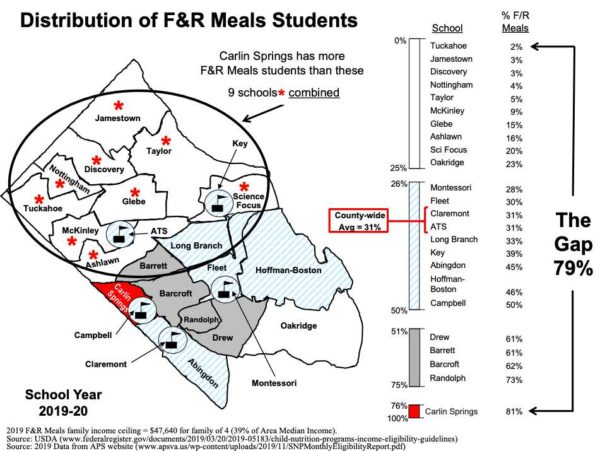Progressive Voice is a bi-weekly opinion column. The views expressed are solely the author’s.
By Reid Goldstein
We all talk about it, but without pulling together, we can’t achieve it. Equity, that is.
Arlington Public Schools’ definition of equity is found in its Strategic Plan, which aspires to “Eliminate opportunity gaps and achieve excellence by providing access to schools, resources, and learning opportunities according to each student’s unique needs.”
However, eliminating opportunity gaps and achieving excellence is more difficult when our students — upper and lower income, native English and English learner households — are separated from their peers due to decades-old land use and housing policies that exacerbate inequity. When the County Board approves new housing developments or expands density in the same few areas of the County, the same set of schools are repeatedly impacted. And where schools are repeatedly impacted, stability is disrupted, and opportunity gaps can and do widen to adversely impact equity in our school system.
Newly approved multi-family residences bring increased school enrollment which inevitably spurs additional relocatables, potential capital expansion, boundary changes, staffing changes, bus route changes, program moves, and parent organization leadership and advocacy changes. While these are normal growing pains, the growing happens repeatedly in the same places.
To eliminate opportunity gaps and achieve excellence, the School Board needs the County Board’s help in managing growth and looking at its consequences, especially where increased density is contemplated. One strategy needs to be a commitment to greater socio-economic integration in the classroom.
Greater classroom socio-economic integration is a path to universal opportunity for a shared educational experience and the social intelligence and awareness that comes from exposure to peers from wide-ranging walks of life. The Century Foundation’s Richard Kahlenberg has written extensively on its benefits. In addition to improved academic outcomes, classroom socio-economic integration can narrow the opportunity gap and create a 21st century workforce and citizenry adept at collaborating across diverse groups.
To reach the excellence that equity promises, all schools require sufficient funding for unique needs, high-quality staffing and professional learning support, and student and family engagement — all factors that strengthen a school’s stability. APS provides additional resources through increased staffing for schools with higher proportions of English learners, as well as staffing and funding through the Federal Title I program for students from economically disadvantaged households. Yet those additional resources have not achieved equity.
On its own, APS has limited tools to accomplish greater socio-economic integration in classrooms. Doing so through boundary readjustment faces the challenge of overcoming the geographic concentration of socio-economic disparities in the County. Relocating students out of their neighborhoods was one factor creating near-universal dislike of busing as that practice played out in the 1970s and 1980s. Further, school boards and communities have to wrestle with which neighborhoods are bused, and why.
A third method, option schools, can encourage a measure of socio-economic diversity. The percentage of students receiving free-and-reduced lunch, a measure of poverty, cluster around the county average at option schools Arlington Traditional School (31%), Claremont Immersion (31%), Key Immersion (39%) and the Montessori Public School of Arlington (28%), for example, in the most recent data available. Yet option schools also come with waiting lists, more students bused longer distances, higher transportation costs, less walking and the character of the school system tipping away from neighborhood schools.
Attaining the kind of equity APS strives for means that both Arlington County Government and APS must be careful to avoid adding more need to schools already impacted by over-enrollment. Each new residential housing development needs to be reviewed to determine what it adds to APS’ benefits and challenges, not simply what it adds to total enrollment, or the tax base. ACG needs to understand the effect on schools — and which schools — before approving any new increase in density.
An ACG-APS partnership is essential because when residential expansion happens in the same few areas of the County — mostly in the major transportation corridors — the schools in that area feel the effects.
Equity is the path to equality of opportunity for our students. But new housing and density decisions continue to affect the same schools in the same parts of the County, creating more need in schools where overcrowding impedes addressing that need. ACG and APS must focus on the goal of equity and work together to attain it.
Reid Goldstein is serving his second term on the Arlington County School Board. His views do not reflect the opinions of Arlington Public Schools or the Arlington School Board.



